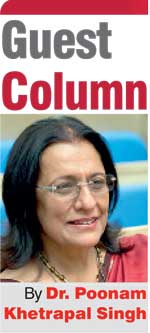Wednesday Dec 17, 2025
Wednesday Dec 17, 2025
Thursday, 23 February 2017 00:00 - - {{hitsCtrl.values.hits}}
The WHO South-East Asia Region is making rapid progress against vaccine-preventable diseases. The Region was certified polio-free in 2014. Maternal and neonatal tetanus was routed in 2016. And routine immunisation for diseases such as diphtheria and  pertussis continues to expand. More than 90% of populations Region-wide are now accessing the life-saving benefits vaccines bring.
pertussis continues to expand. More than 90% of populations Region-wide are now accessing the life-saving benefits vaccines bring.
To add to the Region’s gains, health authorities now have measles in their crosshairs. Measles is a virus that can be transmitted through airdrops, personal contact and infected surfaces. It preys on the young and old, and reserves special ire for the immune-compromised and malnourished. Most disturbingly, it can inflict a range of deadly complications including pneumonia, diarrhoea, encephalitis and malnutrition. It is not without reason that a ninth century Persian physician held measles ‘more to be dreaded than smallpox’.
That the Region’s governments have committed to eliminate the problem by 2020 is to be welcomed. Two doses of measles-containing vaccine have now been introduced in each of the Region’s 11 countries. 95% coverage of both doses – the level needed to establish herd immunity – has been achieved in five of these countries. Where routine childhood vaccination programs are less than ideal, supplementary immunisation drives have helped close immunity gaps. In 2015 alone around 18 million children were reached by supplementary campaigns, while an estimated 640 000 lives were saved Region-wide due to the sum of measles vaccination efforts.
There is nevertheless a need to scale up action against the disease, which remains a major childhood killer, claiming an estimated 54,500 lives in 2015. Up to 5.5 million infants are deprived of even the first dose of the measles vaccine each year, many of whom are the most at risk of death if complications arise. Region-wide coverage of the vaccine’s second dose, meanwhile, is 71%, signifying the need for further gains.
WHO is advocating for all of the Region’s countries to eliminate measles by 2020 – a target that is achievable. For the Region to claim yet another victory in the battle against vaccine-preventable diseases, health authorities and communities Region-wide must act decisively.
To this end, strengthening routine immunisation programs is critical. Though supplementary immunisation campaigns are useful to close immunity gaps in the short-run, routine systems should be strengthened and coverage enhanced.
In each of the Region’s countries the second dose of the vaccine should be provided to every eligible child, and communities being missed should be identified and catered for: At least 95% of children Region-wide should be covered by both doses of measles-containing vaccine. At the same time, in countries where most children are now covered by vaccinations, and where the disease is seen in adults, efforts should be made to achieve immunity at all ages.
Improving surveillance and laboratory capacity is likewise essential. All countries in the Region should strengthen their surveillance systems for detection of all measles cases and to help better target interventions. Though each country has, to varying degrees, implemented functional surveillance systems, not all cases are reported or laboratory confirmed. To turn this around, and to provide the infrastructure necessary to gauge the success of elimination efforts, health authorities should reinforce and expand surveillance to the community level.
In pursuit of these goals, society-wide buy-in is vitally important. This means encouraging health-seeking behaviour when measles-related symptoms such as fever and rash occur. It means addressing socio-cultural issues while creating greater awareness. It means establishing and maintaining political commitment at the local and national level for the pursuit of measles elimination targets. And it means leveraging support from international stakeholders that can help mobilise the resources and know-how capable of making real change possible. WHO is privileged to be a part of these efforts, and to support countries across the Region as they strive to eliminate measles’ preventable burden.
The wider benefits of measles vaccination strengthening will be substantial. This is especially so for the control of rubella, a disease that affects approximately 40,000 births in the Region every year, and can cause a series of heart-breaking conditions such as deafness and heart disease when transmitted from mother to foetus.
At the start of 2017 rubella vaccine was part of a combination vaccine in eight of the Region’s 11 countries. In February, India became the ninth; In August, Indonesia will make it ten. As part of this process, each country will embark on mass immunisation catch-up campaigns. These will have wide-ranging impact in the battle against both diseases, and will enhance the life chances of millions of children in each country.
As countries scale-up their measles immunisation campaigns, this point must stay front-of-mind. By eliminating measles, millions of children will be given the opportunity to grow and prosper where they otherwise may not have. Health systems will be strengthened, and other diseases better controlled. For the South-East Asia Region, and each of the countries within it, measles elimination is a cause worth mobilising for.
(The writer is Regional Director WHO South-East Asia Region.)